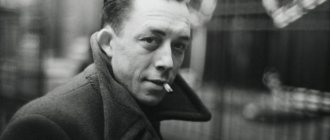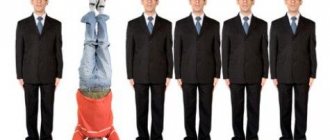People are manipulators (signs)
Keep a close eye on this person. He needs to control the situation at all costs: he is able to impose his will in everything, tries to manipulate any phrase, any situation. Maintain a calm and friendly tone, because you have penetrated his tactics.
A person is not born a Manipulator. He develops the ability to manipulate other people in order to avoid trouble and achieve what he wants, and he develops this ability unconsciously.
The modern Manipulator, Sjostrom believes, has evolved from a market orientation, when a person is a thing that you need to know a lot about and which you need to be able to manage.
Hiding your true emotions is the lot of the Manipulator. The Manipulator sees his main task as making some “proper impression.”
Along with the need to control, the Manipulator feels the need for guidance from above.
Manipulation is not a necessary attitude towards life and does not bring any real benefit. Too often, the Manipulator uses psychological concepts as rationalizations for his dysfunctional behavior, justifying his current unhappiness by citing past experiences and past failures.
A manipulator is a person who has embarked on a path of self-destruction , who uses or controls himself and other people as “things”.
Since the Manipulator lives in each of us to some extent, let's see if we can't highlight it more clearly.
Z-shaped models
Naturally, there are various models of loader cranes, one of which is the Z-design. This type differs from the usual one in the location of the second part of the arrow, which is placed on top of the first part. Thus, the load handle is also at the top. This significantly saves space, which means they become much more convenient to transport. But there are also some drawbacks, one of which is that such equipment has a rather low load moment, which greatly narrows the range of its application.
People-manipulators characteristics of types
- Dictator . Exaggerates his strength. He dominates, orders, quotes authority and does everything to control his victims. Types of Dictator : Abbess, Abbot (Hegumen), Chief, Boss, junior Bosses.
- A wimp (weakling) is usually a victim of the Dictator, the polar opposite. Rag develops great skill in interacting with the Dictator. He exaggerates his sensitivity, he forgets, he does not hear, he is passively silent. Varieties of Rags : Suspicious, Stupid, “Chameleon”, Conformist, Shy, Yielding.
- The calculator exaggerates his control. He deceives, increases, lies, tries to outwit and deceive other people. Variations of the Calculator : Businessman, Fraudster, Gambler, Advertising Creator, Blackmailer, Calculating everything in advance.
- Stuck . It is the polar opposite of the Calculator. He exaggerates his addiction. This is a person who longs to be led, fooled, and cared for. He lets others do the work for him. Varieties : Parasite, Whiner, Eternal Child, Hypochondriac, Dependent, Helpless.
- Hooligan . Exaggerates his aggressiveness, cruelty, and hostility. He is an Abuser, a Hater, a Gangster, a Menace. Female variation - Grumpy woman ("saw").
- Good guy . He exaggerates his caring, love, kills with his kindness. In some ways, confronting him is more harmful than confronting a Bully. The nice guy almost always wins. Varieties : Obsequious, Benevolent, Moralist, Organizational Man.
- Judge . Exaggerates his criticism. He doesn’t trust anyone, is full of accusations, indignation, and has difficulty forgiving. Varieties : Omniscient, Accuser, Gatherer of Evidence, Bailiff, Shame, Appraiser, Avenger, Forcer to admit guilt.
- Defender . The opposite of Judge. He overemphasizes his support and tolerance for mistakes. He spoils others by sympathizing with them beyond all measure and not allowing his clients to get on their feet and grow on their own. Instead of minding his own business, he is ready to take care of the needs of others. Defender Options : Mother Hen, Comforter, Patron, Disciple, Helper, Selfless.
In the Manipulator, one of these types or their combinations are hypertrophied. If we are one of the types of Manipulator to the most pronounced extent, we project its opposite onto the people around us and make them our goals. For example, a Rag wife often chooses a Dictator husband and then controls him using all sorts of subversive methods.
Typology of manipulative character types by E. Shostrom
E. Shostrom, in his book “Anti-Carnegie or the Manipulator,” described what constitutes a type of social character called a “manipulator.”
He needs to control the situation at all costs: he is able to impose his will in everything, tries to manipulate any phrase, any situation.
A person is not born a Manipulator. He develops the ability to manipulate other people in order to avoid trouble and achieve what he wants, and he develops this ability unconsciously.
The modern Manipulator, Sjostrom believes, has developed from a market orientation, when a person is a thing that you need to know a lot about and which you need to be able to manage.
Hiding your true emotions is the lot of the Manipulator. The Manipulator sees his main task as making some “proper impression.”
Manipulation is not a necessary attitude towards life and does not bring any real benefit. Too often, the Manipulator uses psychological concepts as rationalizations for his dysfunctional behavior, justifying his current unhappiness by citing past experiences and past failures.
A manipulator is a person who has embarked on a path of self-destruction, who uses or controls himself and other people as “things.” The manipulator lives to some extent in every person. There are several main types of Manipulator.
1. Dictator.
Exaggerates his strength.
He dominates, orders, quotes authority and does everything to control his victims. Types of dictator: Abbess, Superior, Chief, Boss, junior Bosses.
2. Rag
(weakling) – usually a victim of a dictator, the polar opposite.
The Rag develops great skill in interacting with the dictator. He exaggerates his sensitivity, he forgets, he does not hear, he is passively silent. Varieties of Rags: Suspicious, Stupid, “Chameleon”, Conformist, Shy, Yielding.
3. Calculator
exaggerates his control.
He deceives, exaggerates, lies, tries to outwit and deceive other people. Variations of the Calculator: Businessman, Fraudster, Gambler, Advertising Creator, Blackmailer, Calculating everything in advance.
4. Stuck.
It is the polar opposite of the Calculator.
He exaggerates his addiction. This is a person who longs to be led, fooled, and cared for. He lets others do the work for him. Varieties: Parasite, Whiner, Eternal Child, Hypochondriac, Dependent, Helpless.
5. Bully
.
Exaggerates his aggressiveness, cruelty, and hostility. He: Abuser, Hater, Gangster, Menace.
Female variation -
Grumpy woman.
6. Nice guy.
He exaggerates his caring, love, kills with his kindness.
In some ways, confronting him is more harmful than confronting a Bully. The nice guy almost always wins. Varieties: Obsequious, Benevolent, Moralist, Organizational Man.
7. Judge.
Exaggerates his criticism.
He doesn’t trust anyone, is full of accusations, indignation, and has difficulty forgiving. Varieties: Omniscient, Accuser, Gatherer of Evidence, Bailiff, Shamener, Evaluator, Avenger, Forcer to Confess Guilt.
8. Defender.
The opposite of Judge.
He overemphasizes his support and tolerance for mistakes. He spoils others by sympathizing with them beyond all measure and not allowing his clients to get on their feet and grow on their own. Instead of minding his own business, he is ready to take care of the needs of others. Protector options: Mother Hen, Comforter, Patron, Disciple, Helper, Selfless.
In the Manipulator, one of these types or their combinations are hypertrophied. If a person is one of the types of Manipulator to the most pronounced degree, he projects its opposite onto the people around him and makes them his goals. For example, a Rag wife often chooses a Dictator husband and then controls him using all sorts of “subversive” methods.
Manipulation is a lifestyle, it is a life scenario that regulates the entire system of interaction with the world, aimed at controlling both oneself and others.
27)
The Heymans-Le Senne typology is the most practical and applied. Whatever field of activity we choose, we can find practical application in any of them. It works well in professional activities in the selection of employees and in consulting work, and also explains many issues and problems in family relationships and in family conflicts. This typology is indispensable in everyday life, especially since it is quite simple and understandable. But at the same time, this typology well explains the variety of types of human behavior. For those unfamiliar with psychology and non-professionals, it is convenient because it does not have a large theoretical basis, to understand which you need to read more than one volume of theoretical works. It is built on only three components, which are completely understandable to everyone, and 8 character types are well remembered.
Three components —
emotionality, activity and primacy-secondaryness are taken as the basis for the typology of characters. Based on these three components and their various combinations, Le Senna and Heymans received eight types of characters: 1) stormy, active; 2) passionate; 3) sanguine; 4) phlegmatic; 5) nervous; 6) sentimental; 7) amorphous-carefree ;8) apathetic. Before we begin to consider these eight character types, let us dwell on the meaning and description of the components themselves. Emotionality is how strongly a person reacts to external circumstances, that is, how easily he has an emotional reaction. For example, it is very easy to offend someone with one careless word, while for others even strong indignation does not cause an emotional reaction; some flare up like fire, others react to the same thing quite calmly. If a person has a strong emotionality, then we will designate this as E+, if a person has a weak emotional reaction, then E –. The second component is activity. Activity is an internal need for action or inaction (or for thinking about actions). Some people cannot spend a minute without action, they constantly need to do something, go somewhere, they must be constantly busy with something. Others, on the contrary, are constantly thinking about their actions. They think more than they do, they dream more than they act. If the former are depressed by the state of idleness, then for the latter it is a normal state from which they emerge without enthusiasm. If a person is active, then we will designate him as A+, and vice versa, inactive, as A –. The third component of this typology is the secondary and primacy of nature. Let us denote them with the first letters: B and P. These natures differ from each other in how long and strong the impressions, be they from the external or internal world, remain and continue to hold this personality captive. If a person has secondary traits, then, This means that this person works like a battery or accumulator, that is, he is more “charged” by impressions, they seem to accumulate inside. For example, he does not quickly forget grievances, is under the impression of an emotional experience for a long time, and does not immediately move away from arguments. His mood is even and calm. He rarely gets angry and is rarely seen in a depressed mood. But when he is “discharged,” his anger is powerful, like a “short circuit.” He is faithful to his habits and affections and rarely changes them. It is difficult to switch from one subject to another or from one task to another. If a person has traits of primacy, then this person, unlike what we considered above, does not remain impressed for long. They bounce off it as quickly as a ping-pong ball. If the actions of any factors are taken to be the blow of a tennis ball, then the blow, the response-reaction, seems to return immediately. Such a person easily adapts to reality, quickly changes his priorities, is easy-going, does not get lost in the face of surprises, and loves short activities. So, based on three components, Heymans and Le Senna identified eight characters. Human adaptability Adaptability is the level of actual adaptation of a person, the level of his social status and sense of self - satisfaction or dissatisfaction with himself and his life. A person can be harmonious and adapted or disharmonious and maladapted. Maladaptation is always psychosomatic (both soul and body) and occurs in three forms: neurotic (neuroses), aggressive-protest and capitulative-depressive (psychosomatic diseases and behavioral disorders). A person’s adaptability is ensured by evolutionarily selected ones that are appropriate for his nature. The first component of human nature that ensures adaptability is instincts. According to the concept of V.I. Garbuzov, seven instincts can be distinguished: self-preservation, procreation, altruistic, exploration, dominance, freedom and preservation of dignity.
28)
Adaptation is the level of actual adaptation of a person, the level of his social status and sense of self - satisfaction or dissatisfaction with himself and his life. A person can be harmonious and adapted or disharmonious and maladapted. Maladjustment is always psychosomatic (of both soul and body) and occurs in three forms: neurotic (neuroses), aggressive-protest and capitulative-depressive (psychosomatic diseases and behavioral disorders). Human adaptability is ensured by evolutionarily selected elements that are appropriate for his nature. The first component of human nature that ensures adaptability is instincts. According to the concept of V.I. Garbuzov, seven instincts can be distinguished: self-preservation, procreation, altruistic, exploration, dominance, freedom and preservation of dignity. Depending on the dominance of one or another instinct, the primary fundamental typology of individuality follows. And each person belongs to one of seven types: I – “egophilic”, II – “genophilic” (Latin genus – “genus”), III – “altruistic”, IV – “research”, V – “dominant”, VI – “libertophilic” (Latin libertas – “freedom”), VII – “dignitophilic” (Latin dignitas – “dignity”). Let us present brief personal characteristics within the framework of the above typology. I. egophilic type. From early childhood, a person of this type shows a tendency towards increased caution, the child does not let his mother leave his side even for a moment, is afraid of the dark, heights, water, etc., intolerant of pain; on the basis of this type, a personality is formed with pronounced egocentricity, anxious suspiciousness, and a tendency under unfavorable circumstances to obsessive fears, phobias or hysterical reactions. II. genophilic type. It is characterized by a peculiar kind of ego that is replaced by the concept of “We” (by “We” we mean family) up to the denial of “I”. Values, goals, life plans are subordinated to one thing - the interests of children, family. The evolutionary expediency of having this type lies in the fact that its carriers are the guardians of the family, the guardians of the gene pool of the clan, and the guardians of life. III. altruistic type. People of this type are characterized by kindness, empathy, care for loved ones, especially the elderly, and the ability to give the last to others, even what they need themselves. They are convinced that it cannot be good for everyone if it is bad for someone alone. IV. research type. From early childhood, people of this type are characterized by curiosity, a desire to get to the essence of everything, and a penchant for creativity. At first, these people are interested in everything, but then they become more and more captivated by one passion. Travelers, inventors, scientists are people of this type. V. dominant type. From early childhood, there is a desire for leadership, the ability to organize a game, set a goal, show the will to achieve it, a personality is formed who knows what she wants and how to achieve what she wants, is persistent in achieving the goal, ready to take calculated risks, able to understand people and stories them behind you. VI. libertrophilic type. Already in the cradle, a child of this type protests when he is swaddled. The tendency to protest against any restriction of his freedom grows with him. People of this type are characterized by a desire for independence, denial of authority (parents, teachers), tolerance to pain, a tendency to leave their father's home early, a predisposition to risk, stubbornness, negativism, intolerance to routine, and bureaucracy. VII. Dignitaphilic type. Already in early childhood, a person of this type is able to grasp irony, ridicule and is absolutely intolerant of any form of humiliation. Characterized by recklessness, readiness to sacrifice everything in defending one’s rights, and an unshakable position “Honor is above all.” The self-preservation instinct of such a person is in last place. In the name of honor and dignity, these people go to Calvary without hesitation.
29)
Compatibility of people and typology Several levels can be distinguished in the compatibility of people.1.
The highest and most complex is value-orientation unity: the compatibility of life values, aspirations, ideals, interests, beliefs of people (the closer they are, the easier it is to understand each other and the stronger the compatibility).2. Coherence of a person’s functional-role ideas in a friendly, family, or labor union. For example, if family members have different understandings of their roles and present expectations and corresponding demands that are rejected by others, there will not be the necessary compatibility in the family, but many conflicts will arise. Here, a role is understood as a relatively stable pattern of behavior developed in a given society to implement a certain social function, i.e. behavior that is expected from a person by other people when performing certain functions (in a specific place, in specific circumstances). Inconsistency of ideas about roles, rights, responsibilities, leisure, distribution of household labor, striking discrepancies in everyday habits, etc. can seriously disrupt relationships between people and lead to incompatibility.3. Compatibility of individual psychological characteristics:❖ psychophysical compatibility of temperaments;❖ compatibility of innate qualities of psychosociotypes;❖ compatibility of acquired character qualities; sexual compatibility (it plays an important role in family relationships). In general, the following are necessary: 1. The ability to be critical of oneself.2. Tolerance of others.3. Trust in others. If these qualities are absent, a person cannot get along with other people. To achieve compatibility in small groups when they find themselves in isolation for a long time (polar expedition, crew of a spaceship or submarine), additional factors are required:1 . The maximum possible workload of people with purposeful activities.2. Accuracy in determining the task at hand and the period of coexistence.3. The possibility of privacy for each of the participants. Psychological selection of people according to their level of compatibility is always desirable. Depending on the level of activity/passivity and focus on external circumstances/personal experiences, American psychologists R. Ackoff and F. Emery identify different personality types and predict the degree of psychological compatibility (Fig. 6.12). OA and LP are coordinates for pure types
(person or reacts quickly and actively to external circumstances, without thinking about himself - type OA; or, conversely, is always busy with himself and tries not to be active - LP). The space of OP and LA is for mixed types (a person simultaneously monitors both circumstances and processes in his inner world).
Rice. 6.12. Typology of R. Ackoff, F. Emery
The combination of types gives 10 combinations: OP-LA, LP-OA, OA-LA, OP-LP, OP-OA, LP-LA, LA-LA, OP-OP, LP-LP, OA-OA.
Let us consider the unique behavior of people who make up such couples (for example, married ones) in conflict situations. 1. OP-LA.
If a conflict arises, people of each of the two types believe that it occurred through the fault of the LA (such a person actively realizes only his desires, and is often selfish).
However, paradoxically, both are trying to change the behavior of only the OP, who is influenced without resistance, compliant, as a result of which the conflict is easily extinguished. When a couple has friction with others, it is the OP who perceives the situation more sharply, but due to his passivity, he himself does nothing, but only reports the situation to the LA, after which he actually influences the situation in favor of the couple. Consequently, they do not compete with each other, but cooperate both psychologically and behaviorally.2. LP-OA.
In case of conflict, both of these types believe that the LP is to blame.
But due to his nature, the LP is not too susceptible to the effects of OA for his behavior to change. It is adjusted only after the PL gives an internal assessment of the need for such changes. OA is satisfied with the development of the situation, and the conflict subsides. In the event of a conflict with others, the PL hides behind the OA, allowing him to independently resolve the problems that have arisen and agreeing with his decision. This pair of people is stable and has a clear leader - OA.3. OA-LA.
Both people are sure that the aircraft is to blame for the conflict.
However, everyone tries to change not themselves, but their partner. Only the OA is capable of responding to such efforts (it is sensitive to external influences), but since it has an active character, it does not want to be influenced and does not respond to the actions of the aircraft. As a result, the conflict flares up, with OA playing a more active role in it. In relationships with others, both strive to influence the outside world (neighbors, colleagues, relatives, children) and conflict with each other over the management of this influence. The couple finds it difficult to get along with the people around them and is quite conflictual in their internal relationships.4. OP-LP.
In the opinion of both, the LP is to blame for all the problems, although each seeks to change only himself.
The OP believes that he is constantly sacrificing himself for the sake of a peaceful relationship, but the LP does not see these sacrifices and does not show whether he appreciates the OP’s self-sacrifice. This does not contribute to the stability of the couple. This couple is most often unable to change the environment in order to reduce the severity of external and internal problems. She is perceived as a passive, inactive couple, dissatisfied with each other.5. OP-OA.
Everyone understands well that the conflict that arises between them affects the behavior of their partner.
However, OP is trying to change herself, and OA is only trying to change the other side. Because she is susceptible to outside influence, she responds to the OA's demands and peace is restored. At the same time, the establishment of harmonious relationships of such a couple with other people is hampered by the fact that the OP and OA see the problems that arise with others differently. In addition, they unwittingly transfer the conflict into the sphere of their interpersonal relationships. In order to maintain stability, they need (and they try to do this) to reveal to each other their views on the environment and their relationships as little as possible, because almost any statement leads to a quarrel. In the eyes of others, this is a couple in which one of its participants is under the “shoe.”6. LP-LA.
Each of them is very indifferent to the actions of their partner and responds poorly to them.
At the same time, the LA is trying to use the second side for its own purposes, but since it is very insensitive to such influence, these attempts fail. Over time, the LA's desire to influence the situation wanes, and the partners move away from each other. They are inactive in relationships with others, as they are busy with their own problems. From the outside they seem peaceful, although rather indifferent to their partner. Under unfavorable circumstances, this indifference can provide the couple with a certain stability.7. LA LA.
In case of conflict, everyone considers the problem from the point of view of how it can affect their personality, without taking into account the partner’s reaction, and seeks to influence the other in order to achieve their goals.
Both, however, do not succumb to such influence, do not react to it, and therefore conflict a lot without apparent success. Both are unaware of their impact on others, nor of how external circumstances affect the couple’s relationship. At the same time, both are trying to change other people, but they are making efforts separately, trying to turn things in their favor. From the outside they look like an aggressive, conflicting (quarrelsome) couple who do not understand what the world around them is like and what is happening in it.8. OP-OP.
According to each partner, the cause of the conflict lies in the actions of the other.
At the same time, both strive to avoid collisions, which stabilizes the couple as a whole. They see external circumstances in the same way, but everyone is either passive or trying to solve problems on their own. They do not try to change the environment through joint efforts. Outwardly, they are a peaceful, passive, partly friendly and compliant couple, although uncommunicative.9. LP-LP.
Each does not respond too much to the actions of the other, so they do not conflict, but they do not interact either.
Without pestering himself, he is glad that he is not offended either. The conflict that arises fades away very quickly, since no one is throwing wood on the fire. The couple does not communicate, and therefore does not conflict with other people. When external circumstances change, everyone tries to independently adapt to the changes. To those around them, this couple does not seem very interesting, although they are peaceful.10. OA-OA.
“The other is to blame for everything” - this is the point of view shared by this couple, therefore each partner considers it his duty to try to change the behavior of the other, but the other does not respond to his efforts. Everyone thinks that the other side does not understand him, and he tries to prove that he is right. The conflict over this does not go away for a long time. To achieve peace, both can try to change the environment, but even in this case they will compete with each other. Having started a conflict with people, they certainly argue with each other. Those around them perceive this couple as quarrelsome and hostile. Its stability is minimal. Numerous studies on the compatibility of people have made it possible to formulate its main law: the innate qualities of partners should be contrasting, while the acquired qualities should be similar. The union of spouses who are not too different in their origin, living conditions, and upbringing is more durable because in this case, the likelihood that attitudes, values, interests, ideals, habits (i.e., acquired qualities) will coincide is obviously higher.
30) Motivation
(from lat.
movere
) - incentive to action; a dynamic psychophysiological process that controls human behavior, determining its direction, organization, activity and stability; a person's ability to actively satisfy their needs.
Extrinsic motivation
(extreme) - motivation that is not related to the content of a certain activity, but is conditioned by circumstances external to the subject.
Internal motivation
(intrinsic) is motivation associated not with external circumstances, but with the very content of the activity.
Positive and negative motivation
.
Motivation based on positive incentives is called positive. Motivation based on negative incentives is called negative. Example: the construction “if I clean up the table, I will get candy” or “if I don’t play around, I will get candy” is a positive motivation. The construction “if I clean up the table, then I won’t be punished” or “if I don’t play around, then I won’t be punished” is a negative motivation. Sustainable and unstable motivation
. Motivation is considered sustainable if it is based on a person’s needs, since it does not require additional reinforcement. There are two main types of motivation: “from” and “to”, or the “carrot and stick method”. Also distinguished: individual motivations aimed at maintaining homeostasis, hunger, thirst, avoiding pain, striving for temperature optimum; group, caring for offspring, finding a place; in a group: hierarchy, maintaining the community structure inherent in a given type, cognitive: investigative behavior, play activity
Why do people become manipulators?
The main reason for manipulation , Frederick Perls believes, is in the eternal conflict of a person with himself, so a person never trusts himself completely, but he does not trust others even more. “So he takes the path of manipulation so that the “others” are always on his leash, so that he can control them and, in this condition, trust them more.”
Erich Fromm puts forward the second reason for manipulation : wanting to receive love, the manipulator seeks to gain complete power over another person: power that forces the other person to do what HE wants; think what HE wants; feel what HE wants.
The third reason for manipulation : since risk and uncertainty surround people on all sides, a person often feels helpless, so a passive manipulator says: “I can’t control everything that can happen to me, so I won’t control anything. I give up, do what you want with me!” - and at the same time, ultimately - achieves his goals using his external helplessness. An active manipulator actively takes advantage of the powerlessness of other people, enjoys dominating people, trying to make them as dependent on himself as possible.
The fourth reason for manipulation : a manipulator is a person who seeks to avoid intimacy in relationships and difficult situations, therefore treats people ritually (E. Bern, V. Glasser).
Fifth reason for manipulation : a person strives to gain the approval of everyone, so he is forced to pretend, hide his feelings, thoughts and desires, cannot be truthful and honest with others, but by hook or by crook he tries to please everyone (A. Ellis).
Machine technical parameters
These machines have quite a lot of different technical characteristics that affect not only the cost of the device itself, but also, for example, the services of the crane. These parameters include the following:
- the maximum and minimum distance to which the boom extends or retracts;
- load capacity, determined at maximum and minimum distances;
- there is also the value of the load moment of the boom, determined in the same two positions;
- height of raising and lowering the object;
- there is also a value for the minimum turning radius of the entire crane;
- quality and performance of the suspension.
These technical parameters apply to the entire installation. However, there are also some design features of the CMU boom itself, which every crane operator should already know.
- Cross-sectional shape. This shape most often has four, five, six or eight sides. The greater their number, the stronger the arrow is considered.
- It is very important to understand the boom telescopic system. It can be either random or sequential.
Secrets of successful human manipulation
Manipulation is a lifestyle, it is a life scenario that regulates the entire system of interaction with the world, aimed at controlling both oneself and others. For example, the Rag wife turned her entire existence into an invisible campaign to make her Dictator husband responsible for all her life's troubles. This is not just a separate random game, this is a scenario for their entire life together.
Four main manipulative systems can be distinguished .
1. Active Manipulator tries to control others using active methods. He avoids showing his weakness in relationships, accepting the role of being full of strength. Usually he is attracted to this by his social position (parent, older brother, teacher, boss). He plays the trampler and achieves satisfaction by gaining control over other people, but is dependent for his satisfaction on the feeling of their powerlessness. He uses the technique of establishing rights and duties, tables of ranks, etc., controlling people like puppets.
2. The passive manipulator is the opposite of the active one. He decides that since he cannot control life, he will give up effort and allow himself to be controlled by an active Manipulator. He pretends to be helpless and stupid and pretends to be “trampled on.” At the same time, a passive manipulator wins through defeat. By allowing the active Manipulator to think and work for him, he, in a certain sense, defeats the “trampling” one with his lethargy and passivity.
3. The Competitive Manipulator views life as a state that requires constant vigilance, since here you can either win or lose, there is no other option. For him, life is a battle where all other people are rivals or enemies, real or potential. He oscillates between the methods of “trampling” and “being trampled” and therefore can be considered as a cross between a passive and an active Manipulator.
4. The system of indifferent manipulation is the main form of the manipulative system. The manipulator plays the role of an indifferent person, hoping for nothing and trying to slip away and avoid contact with the partner. His catchphrase: "I don't care." He treats the other person like an inanimate doll. His methods are also either passive or active, sometimes he plays "Boredom", sometimes "Grumpy Saw", "Martyr" or "Helpless". His secret, of course, is that he doesn’t give a damn, otherwise he wouldn’t continue his manipulations.
Similar relationships often exist between husbands and wives. An example of this is the “threat of divorce” game, when the Manipulator hopes to subjugate his partner, and not at all to separate from him. Since the Manipulator behaves with another as with an inanimate object, such an indifferent attitude gradually kills the soul in him. That is why they call his attitude towards others self-destructive.
CRY IT'S HEALTHY
Emotions are the means by which we communicate with each other. We can speak to another person softly or angrily, plaintively or arrogantly - all in order to establish one type of contact or another. That is, contact between people is established only if they show emotions.
However, let’s not overestimate the positive role of emotions, implying that emotions are different. The manipulator, as a rule, has difficulty and poorly expresses the basic emotions of contact - anger, fear, resentment, trust and love. Therefore, he resorts to blocked or incomplete emotions - anxiety, bitterness, indignation, shyness.
Anxiety is like a sucking feeling of hunger. A person who is anxious does not take full action and is busy suppressing growing aggression, as a result of which he falls into apathy.
Bitterness can last indefinitely if it is not allowed to splash out in deep resentment and sobs.
Indignation is the most typical incomplete emotion. And - deceitful. In fact, indignation is unnatural and a suppressed expression of fear.
Shyness is a very strange emotion because it denotes both a tendency to create contact and avoid it. Perls called the emotions of shame and shyness “betrayal emotions” because they interfere with a person and limit his freedom.
All these emotions are extremely dangerous, because unexpressed emotions that have not found a way out are driven into the depths of the soul, which subsequently overloads the human psyche, destroys it from the inside and leads to resignation and depression.
A mandatory requirement for those who want to get rid of the manipulator in themselves is to realize where and how he shows partial emotions, determine which ones, and try to discern the real feelings that are hidden behind them. And then - do not be afraid to express these basic feelings, be it fear or resentment, anger or love. The goal of an actualizer is to develop the ability to honestly express your true feelings.
“Don’t get upset... Control yourself... Take it easy,” the manipulator constantly advises you. Well, that's quite understandable. He has already used these recommendations, and he feels bad. In order to somehow console himself, he wants to ruin your life too.
Besides, he doesn't want to let you get angry with him. Just when you wanted to be indignant, he puts his finger to his lips and says: “Shh, calm, quiet, don’t be upset, it’s harmful.” Don’t believe him, and then the manipulator is not scary for you. And remember, the main defense against his manipulative, destructive influence is the ability to express your own feelings.
The difficulty is that most of us do not understand what it means to experience, much less express, our feelings. We are so accustomed to pretending that we can no longer distinguish “us” from “strangers,” that is, “fake.” That’s why we are glad to learn how to express them, but we don’t know who “them” is. And as a result, they are doomed to live forever in the Tower of Babel. So let's take a closer look at the five main emotions of contact, so that we can subsequently recognize and express them.
1. ANGER. What do the physiological signs of anger look like? What is your body telling you? How do you know when you are angry? You want to fight, that's what it is. How do you know when you want to fight? Your body is just screaming about it. Your breathing and heart rate quicken, your muscles contract, and you feel an unexpected and sharp rush of heat, a hot feeling of a sudden rush of blood.
Whether it's a verbal or physical fight, or maybe a short burst of irritation, our bodies definitely have to do something when we get angry. They simply demand action from us. And the worst thing we can do for ourselves is to suppress our physiological needs, push emotions inside, and artificially calm ourselves down.
2. FEAR. How do you know when you are afraid? What is your body telling you this time? It gives you exactly the opposite signal. Your mouth becomes dry, your palms become clammy, you feel cold and your skin breaks out in goosebumps. By overcoming fear, you are also doing yourself a disservice.
3. RESULT. Most of us, consciously or subconsciously, are afraid of being offended. I think this is the fault of the many manipulators we meet at every turn. And at every step they forbid us to offend their feelings. Therefore, our motto became such an unnatural statement: “I would not like to offend ...” - then a long list of people could follow, which in short would look like this: “Everyone!”
Why not offend? - I’ll ask you if a person deserves it. By offending, you often greatly help the one you offend; Trying not to offend, you often cruelly punish a person.
You see, a teenager quietly takes his parents’ car, and you remain silent, don’t say anything to him, for fear of offending him. How will you evaluate your “delicate” actions after it breaks? After all, you knew that he hardly knows how to drive a car well...
The unreasonable narrowing of our inner world in order not to offend someone or harm something is, of course, a symptom of neurosis. So let's be honest with ourselves - why are we doing this? After all, the main reason is not that we are afraid of offending others, but that we are very afraid that they will offend us in return. In the case of a thieving teenager, there are many such possibilities. He can be rude to you, he can take revenge, he can say that your son is secretly taking your car... He has every opportunity to hurt your pride and humiliate your dignity. “So why take the risk? - you think. “Let him fight if he wants.” I mean, no, you don't think so. But the manipulator certainly thinks. Such a scoundrel.
Resentment is the most difficult feeling to express. It encourages us to return to childhood and remember the state when we sought protection from our mother everywhere and in everything. How could she help us? As a rule, by listening to our lamentations. This is the best way to express resentment. We need to reprimand her and cry. Women cope better with this; men are not at all inclined to this. Well, they live shorter lives and have heart attacks more often. They hope that jogging in the morning will prolong their life. And they should cry sometimes...
Once upon a time in childhood, some manipulator told them: “Come on, Johnny, big boys don’t cry.” And as a result, they simply don’t have the courage to cry.
Unexpressed resentment becomes a noose around a person’s neck.
4. TRUST. It is experienced in a feeling of openness. That is, you reveal the hidden corners of your soul and, as it were, say: here I am, in full view, look, I’m not afraid of you. At the same time, you get rid of the usual lack of freedom and, as it were, gain a second wind. By trusting, you willy-nilly become yourself.
5. LOVE. This is the golden key to the creative use of all other senses. Shelley called it “the food of poets.” Goldsmith - "communication between tyrants and slaves." But the closest thing to a psychologically correct definition is Rilke’s “diagnosis”: “Love consists in the fact that two solitudes greet each other, touch and protect each other.” Of course, the best book about love is the book by Erich Fromm. “Love,” says Fromm, “is active participation in the life of another person and accepting him as he is.”
Our body won’t deceive us here either and will let us feel in love. What can you compare it to? If anger is a hot emotion, then love is warm and glowing.
The interesting thing is that anger and love are very close. They seem to grow from the same root. And for many, it is necessary to first feel a surge of hot anger before feeling the warmth of love.
A person can never have true and lasting relationships with others and can never love if he is unable to face them, if he cannot express all four feelings. Only when we are able to show that we are angry, afraid, offended or believe, only then can we love. Only when we can openly show each other our feelings and speak openly about them, only then can we feel spiritual intimacy - which, by the way, is no less pleasant than physical intimacy.
All this should be kept in mind, especially in family life.
Psychotherapists who are approached by married (or married) people prefer to deal with the husband and wife at the same time, since in family life, more than anywhere else, harmony and unity of goals are needed. If one of the spouses learns to honestly express their feelings, and the other shamelessly manipulates, the family is doomed. Two actualizers can be happy; two manipulators will be able to get used to each other and adapt to their partner’s games. But the union of manipulator and actualizer is unthinkable.
The most interesting thing is that the manipulator can experience many feelings quite sincerely, but he will certainly try to use them “for something useful,” as he thinks. That is, in addition to sincere tears, a certain manipulative goal is given.
Anger, for example, can be used by him to scare. You, of course, have often met manipulators who, with their screaming and squealing, red face and stomping their feet, did not allow others to establish contact with them.
Boom equipment
Another important element of the entire structure is the boom. According to the type of suspension, this device can be of two types - hinged, which is considered rigid, or rope, which is considered flexible. If the boom device has a rope design, then the crane operator grabs the load using a hook, which is located at the end of the boom. If the design is rigid, then the load gripper is attached to the boom head using a hinge.
It is also worth highlighting the external component of the arrow. It can be Z-shaped or L-shaped. These names were given to the devices because of their appearance when folded.
If we talk about the design of the first type, then it is considered a European model, since these are the manufacturers who most often use this method. This type of boom allows it to be folded into several bends, which allows you to significantly save space and place such structures behind the vehicle cab. When unfolding a CMU of this type, it turns out across the car frame.
The L-shaped type is most often used by Japanese, South Korean and North American designers. This type of CMU has a straight telescopic boom. A cable is used as a suspension for the hook.











